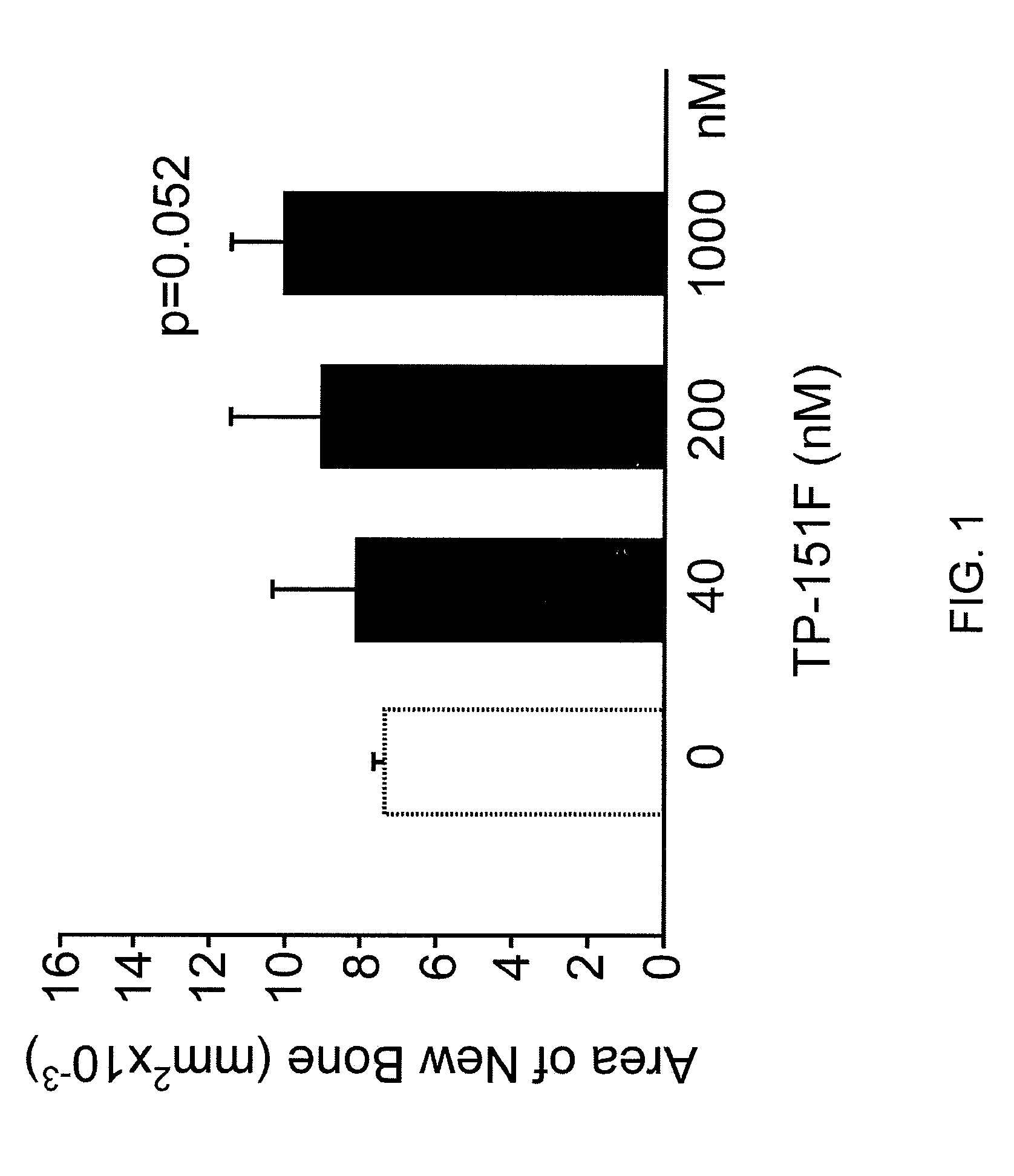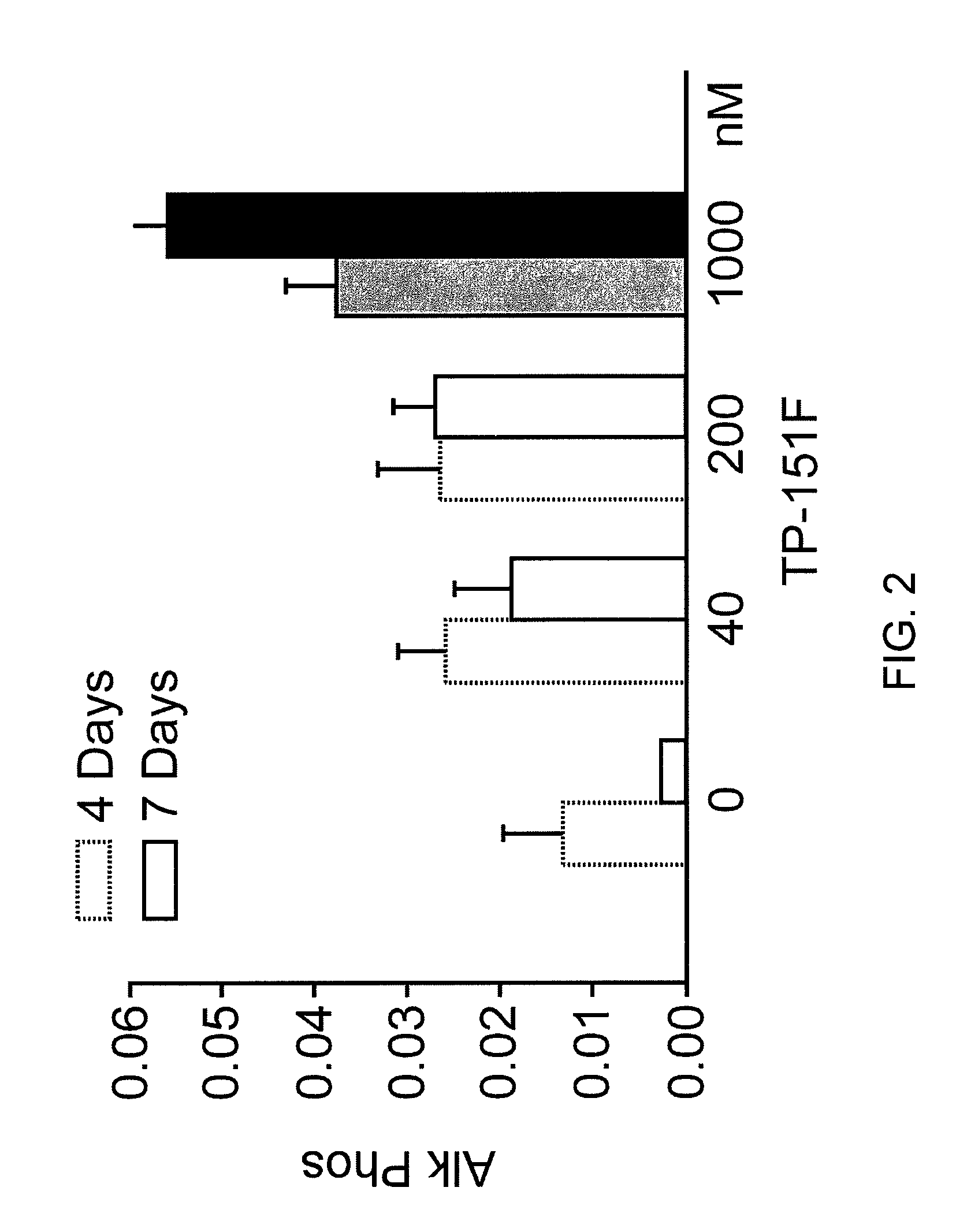Synthetic triterpenoids and tricyclic-bis-enones for use in stimulating bone and cartilage growth
a technology of tricyclic bisenone and synthetic triterpenoids, which is applied in the field of biotechnology and medicine, can solve the problems of increasing the risk of infection, reducing the number of bone grafts, and rejecting the gra
- Summary
- Abstract
- Description
- Claims
- Application Information
AI Technical Summary
Benefits of technology
Problems solved by technology
Method used
Image
Examples
example 1
Materials And Methods
[0338]Neonatal murine calvarial bone formation assay. The technique for studying organ cultures of neonatal murine calvarial bones has been described in detail previously (Traianedes et al., 1999, Mundy et al., 1999). The bones were removed from the calvaria of 4-5 day old ICR Swiss mice, and then cultured in BGJ medium with 0.1% BSA for 7 Days using 4 calvarial bones per group triterpenoids in differing amounts were added for 7 days. Alkaline phosphatase was determined at 4 and 7 days and expressed as arbitrary units of alkaline phosphatase activity. At the end of the experiment the media was saved and assayed for the presence of alkaline phosphatase and the calvaria bones were then fixed overnight in 10% formalin, decalcified in 14% EDTA overnight and were then embedded in paraffin wax. Sections were cut, using a standard microtome, along the midline suture to reveal the sagittal suture and the region posterior to this suture. Four micrometer sections were tak...
example 2
Calvarial Bone Formation Results
[0343]Experimental groupings for FIGS. 1-12 are shown below (The alphabet at the end of each compound number denotes synthesis batch of each one.):
[0344]
Gp1 - ControlGp2 - TP-151F40NmGp3 - TP-151F200nMGp4 - TP-151F1000nMGp5 - ControlGp6 - TP-155C40nMGp7 - TP-155C200nMGp8 - TP-155C1000nMGp9 - ControlGp10 - TP-235H40nMGp11 - TP-235H200nMGp12 - TP-235H1000nMGp13 - ControlGp14 - TP-319A40nMGp15 - TP-319A200nMGp16 - TP-319A100nM
Results were expressed as new bone formation and alkaline phosphatase in the media at 4 and 7 days. Midshaft transverse fractures were induced in all animals. Fractures were tolerated and remained immobilized without surgical complications. Animals were freely mobile after recovery from anesthesia. Callus formation was observed on radiographic examination by 2 weeks in all animals. The animals were euthanized at 3 weeks and callus formation and the biomechanical strength of the bones assessed
[0345]TP-151. Significant increase in new...
example 3
Articular Cartilage Results
[0349]TGF-β1. Recombinant human TGF-β1 was found to up-regulate SZP synthesis in a dose-dependent manner (0.4-120 pM).
[0350]Triterpenoids at higher concentrations. All four triterpenoids tested, TP-151, TP-155, TP-235, and TP-319, down-regulated SZP synthesis in a dose-dependent manner at high concentrations (100-1000 nM). Concurrent treatment with TGF-β1 (4 pM) also demonstrated the same trend.
[0351]Triterpenoids at lower concentrations. TP-151 and TP-155 up-regulated SZP synthesis at lower concentrations, with SZP synthesis increasing as the concentration of these two triterpenoids was increased from 0.01 to 1 nM. TP-235 and TP-319 had no obvious effects in this range.
[0352]The results suggest that sub-nanomolar concentrations concentration were optimal for articular cartilage.
PUM
| Property | Measurement | Unit |
|---|---|---|
| length of time | aaaaa | aaaaa |
| length of time | aaaaa | aaaaa |
| diameters | aaaaa | aaaaa |
Abstract
Description
Claims
Application Information
 Login to View More
Login to View More - R&D
- Intellectual Property
- Life Sciences
- Materials
- Tech Scout
- Unparalleled Data Quality
- Higher Quality Content
- 60% Fewer Hallucinations
Browse by: Latest US Patents, China's latest patents, Technical Efficacy Thesaurus, Application Domain, Technology Topic, Popular Technical Reports.
© 2025 PatSnap. All rights reserved.Legal|Privacy policy|Modern Slavery Act Transparency Statement|Sitemap|About US| Contact US: help@patsnap.com



